Tips of Presentation
- History of fairy tales and the background for animation.
- Storytelling and its stylistic coloring.
- Character Design.
- Mood.
- Animation Techniques.
- Timing, exaggeraion, and appeal.
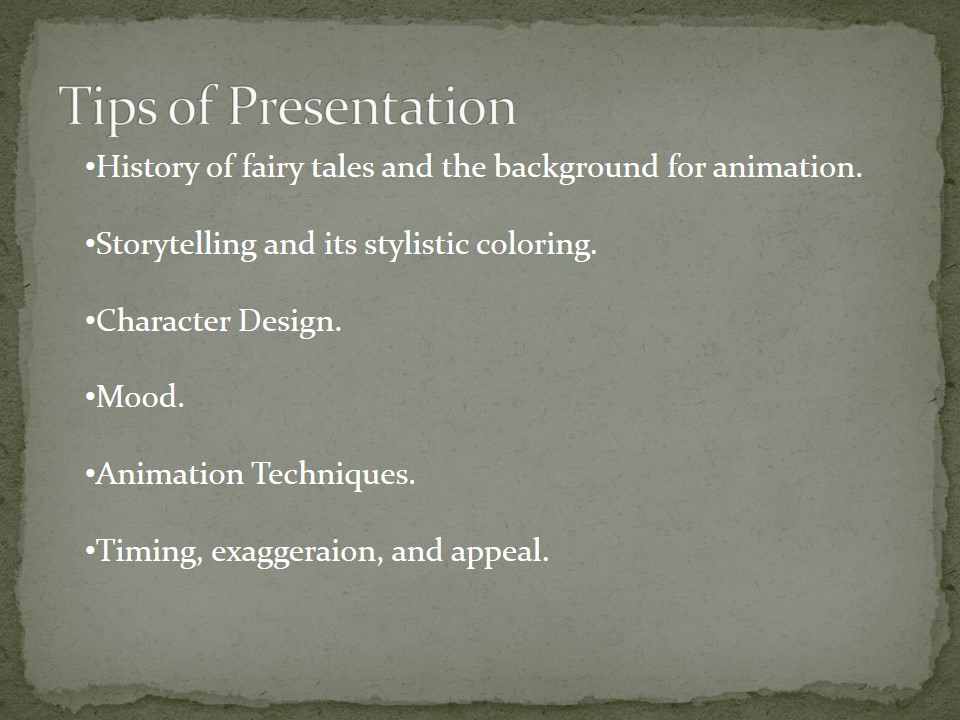
New History of Fairy Tales
- Since ancient times the progress in printing made possible for people to illustrate their fancies.
- In the twentieth century the fairy tale flourished in the frame of animation.
- Tex Avery became one of the most outstanding figures in cartoon-making.
- The educational and moral value of Avery’s cartoons made his implementation of scenarios and patterning worth watching for both children and parents.
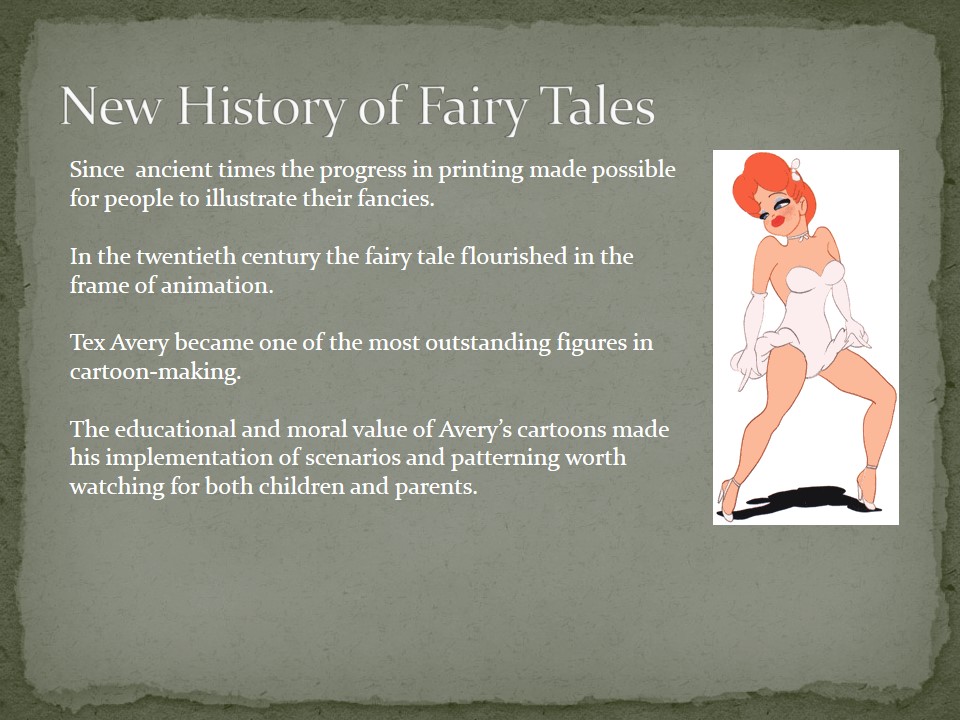
Tex Avery, and his approach to fairy tales
The adaptation period of fairy tales to new milieu of entertainment and direct implementation gave animators a possibility to increase their whole outlook on the reality of cartoons, as vivid and impressive genre in cinema.
Tex Avery was fairly called, as the funniest producer of fairy tales framed in the achievements of cartoon-making.
Red Hot Riding Hood is the author’s interpretation of classical the Little Red Riding-hood. This grave example expresses the desire of Avery to adopt traditional understanding of a fairy tale to real conditions and vogue tendencies in the society.
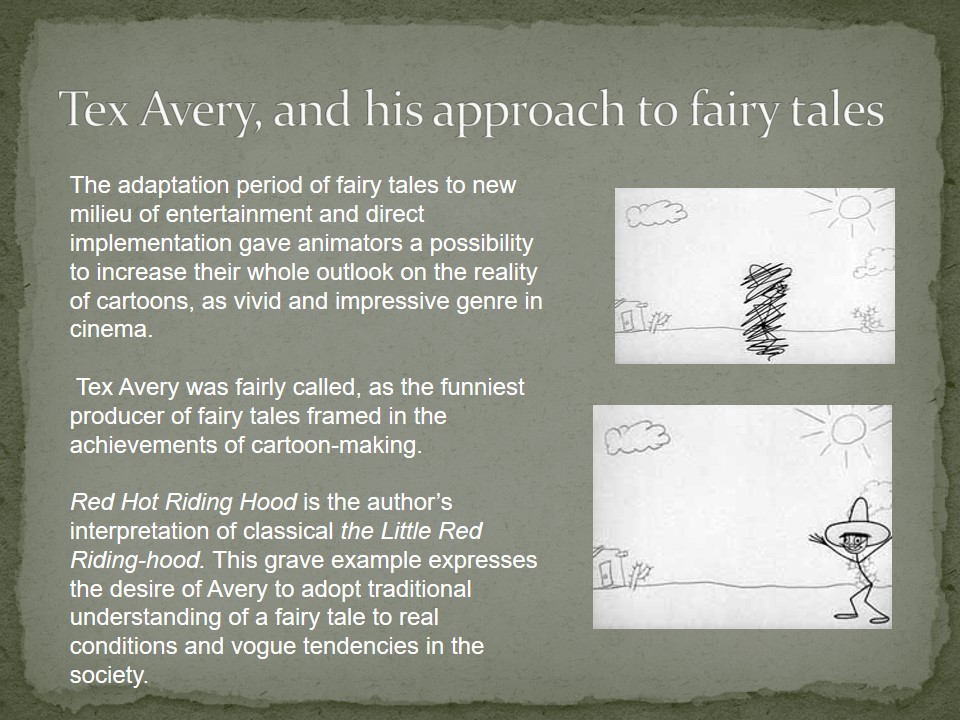
Notion of splendor
Tex Avery saw the splendid representation of cartoon as well as its destination in making things known to everyone transformed into trendy motives which drove society, for example, in time of Great Depression.
In this case the animator was quite talented and self-confident in making world of cartoons applied with popular philosophical background. Freudian theory is quite obvious in Avery’s creative work.
His splendor on the example of Red Hot Riding Hood is patterned with mere extent of hitherto unseen correlation of popular mould-breaking trends in the society with classical promotion of so untouchable sphere of folk implementation, as fairy tales.
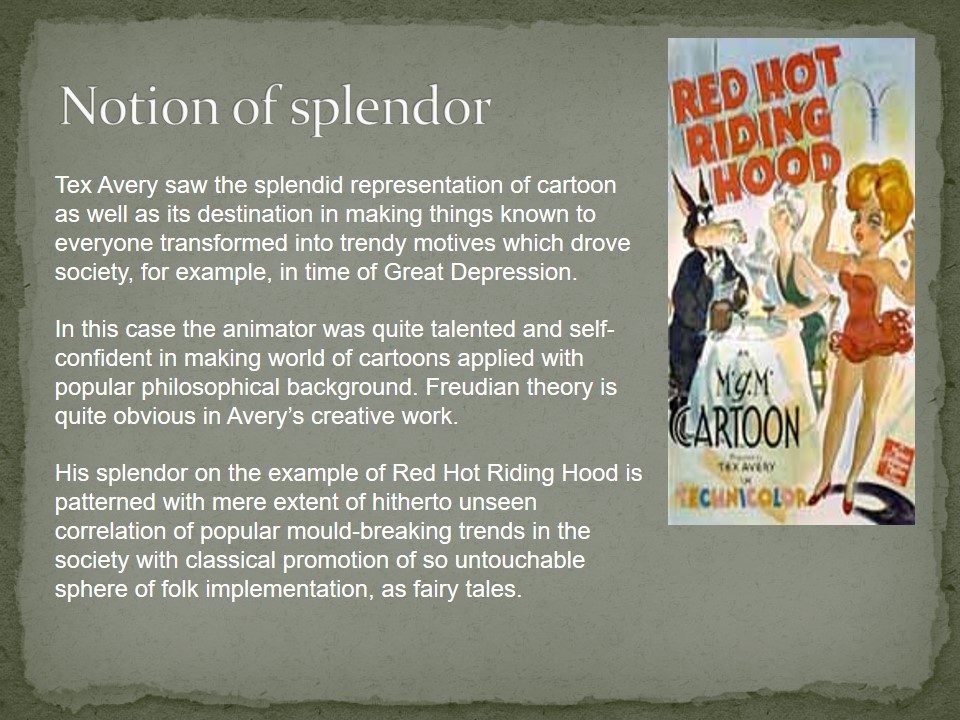
Avery and his idea of cartoon
Avery wanted to impress the publicity with the colourful representation of main characters.
His ideas contemplated the peculiar way of development in philosophy and literature.
“Avery’s fairy tales jettison the whole idea of morality, along with other troublesome concepts like logic, sense, and sexual repression” (Morris 1).
His style can be characterized by a terrific and zany sense of humor (Young and Heisie para. 7).
His straightforwardness amazed contemporaries with a specific “bizarre directional style“(Young and Heisie para. 7).
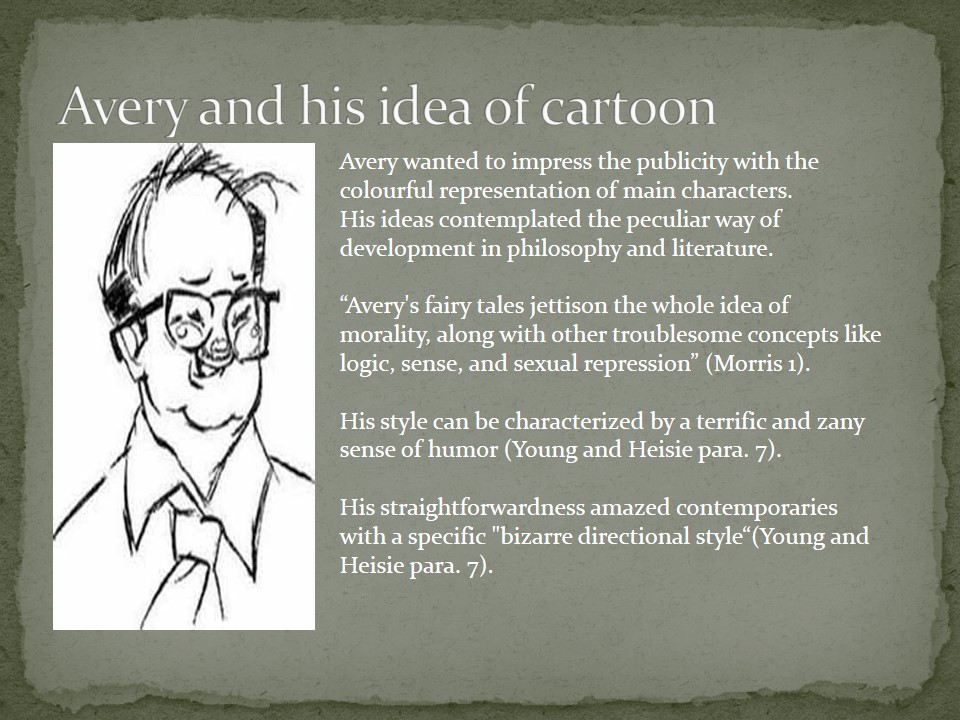
Avery enlarges vision of cartoons
Living in different periods of American realities in the twentieth century Avery never betrayed his strong recognition about the functional framework of cartoon, as art. Together with Chuck Jones and other collaborators he succeeded in showing cartoons with mere societal hints.
Absurdism and abstraction were the main fields for him within which actions should be performed in cartoons.
Here arises a logical explanation of why Avery in his creative work differed (in a positive way) from most of his colleagues, namely Walt Disney, William Hanah and others.
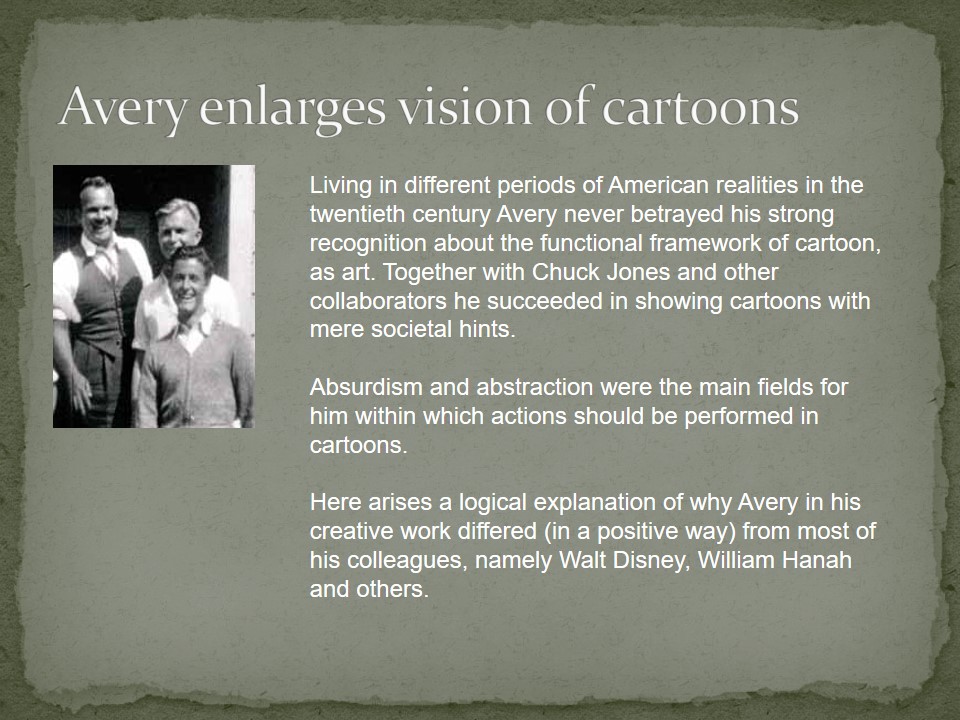
Character Design
Characters by Tex Avery were not only the funniest representation for children, but also the way to show some social drawbacks by means of ignorance, for example, of physical laws .
Avery wanted to show in his creations peculiarity and change in their characteristic traits.
The Screwy Squirrel , Droopy, Spike and others realized the dream of Avery to describe ideas of the time for making children “sophisticated, willful creatures with a bottomless bag of tricks” (Young and Heisie para. 9).
In terms of designing characters Tex Avery never hid his sub textual sense of them.
He tried to make “set of gags, complete with stirring variations”, so that not to outline the shorts of his with silliness (Ford para. 21).
The Slap-Happy Lion shows an extent of Avery’s laughing at those people in the society who pretend to be called magnificent without any ground to think so.
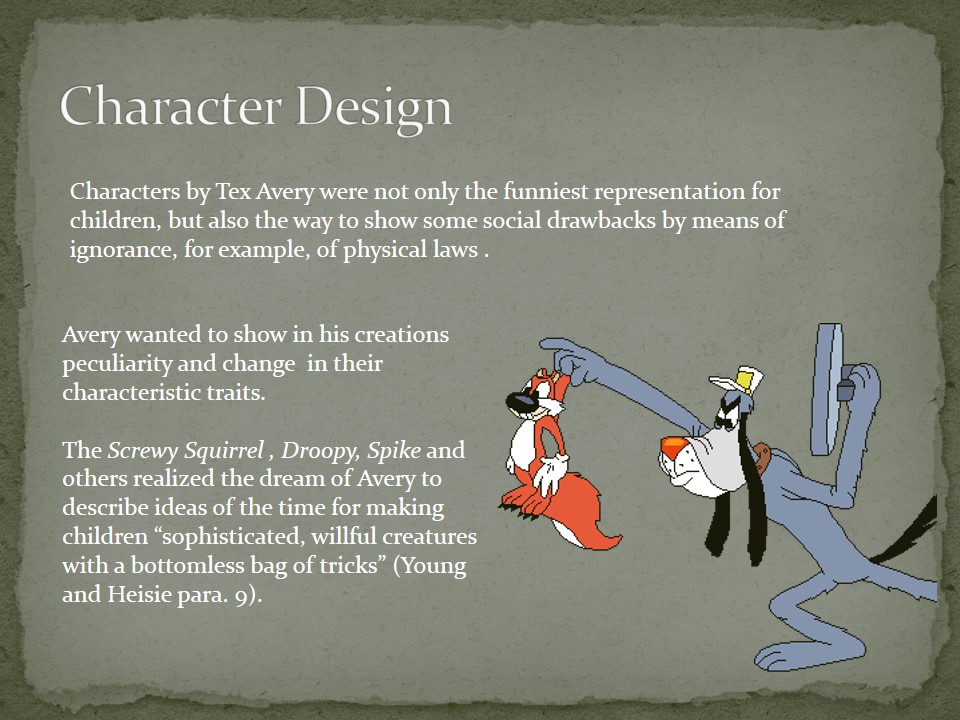

Mood of Avery’s cartoons
The author of so funny cartoons was interested too much in the trendy movements of the time. This is why he adored Beat culture and the works by famous Modernist writers.
His manner and perception of the society is implied into the phrase that “Every man in America feels the need to re-create his childhood home” (Barrier para. 13).
The main dissatisfaction from the side of producers could touch upon Avery’s single-mindedness in his artistic work (Barrier para. 14).
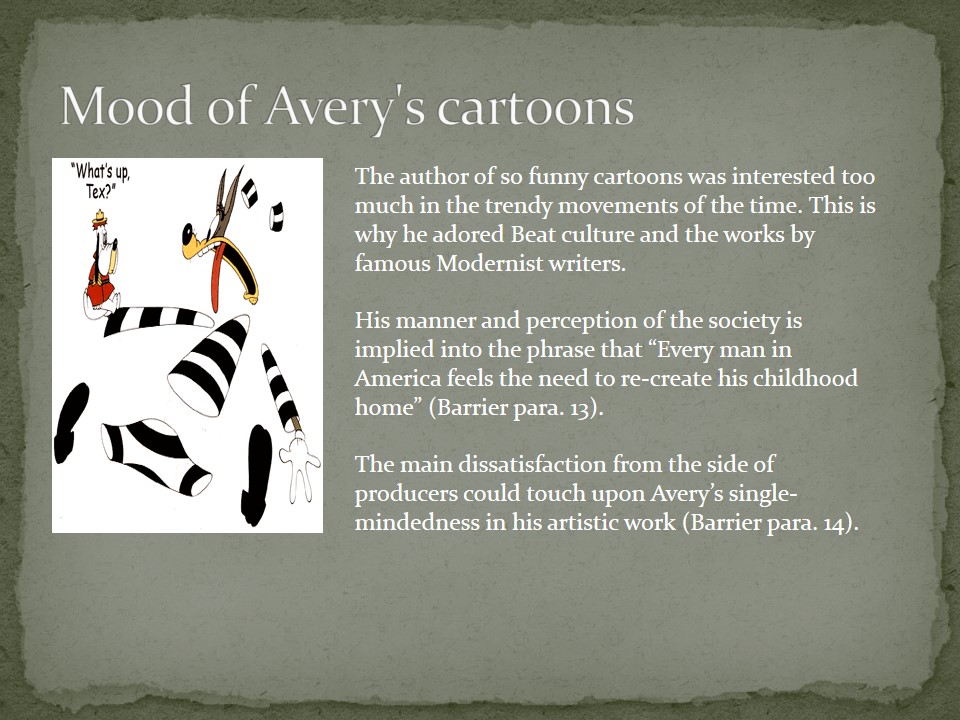
Antithesis to Disney’s cartoons
Many critics of cinema opposed Tex Avery to Walt Disney in their definitely different implementation of main ideas in characters and their further disclosure in the cartoon.
School of Avery appraised the nominative role of imagination and its freedom in the medium.
Avery’s self-reflexivity, irony, comical allusionsto social reality and impatience with fairy-tale clichés made him a direct “antagonist“ in relation to Disney (Haase 948).
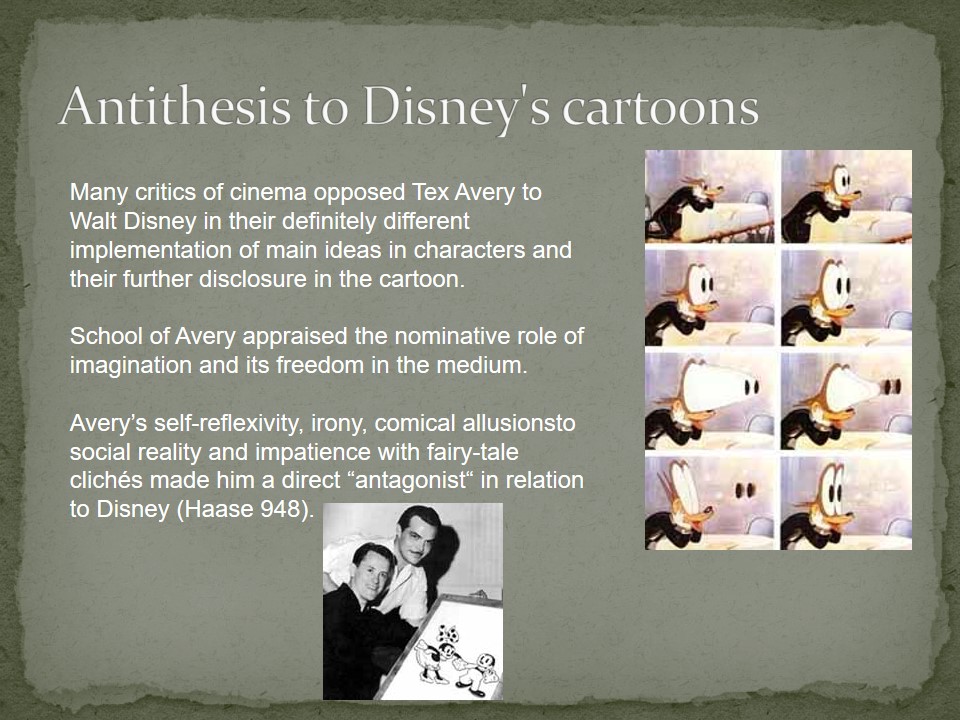
Camera angles
Tex Avery was a master of spontaneous and rather vivid and full of sense funny scenes.
In this respect right camera angle was the factor which gained originality of his manner.
A particular feature was concerned with frequent use of off-screen and on-screen foreshortening.
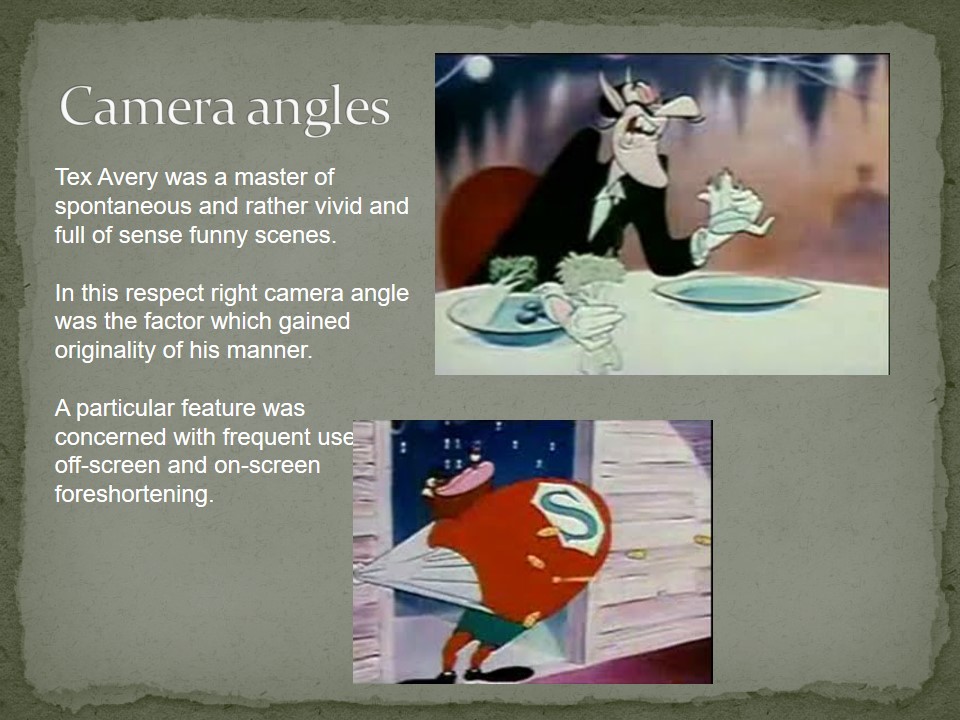
Camera techniques
Creative distances techniques of Tex Avery promoted a feeling of spatial abnormality and absurd of characters and objects in cartoons.
Attention to the signs or phrases decorated on plancards.
“Tex Avery’s visual diction is distinctly modernistic, and so constantly reinforces our awareness that we’re watching a cartoon” (Ford para. 32).
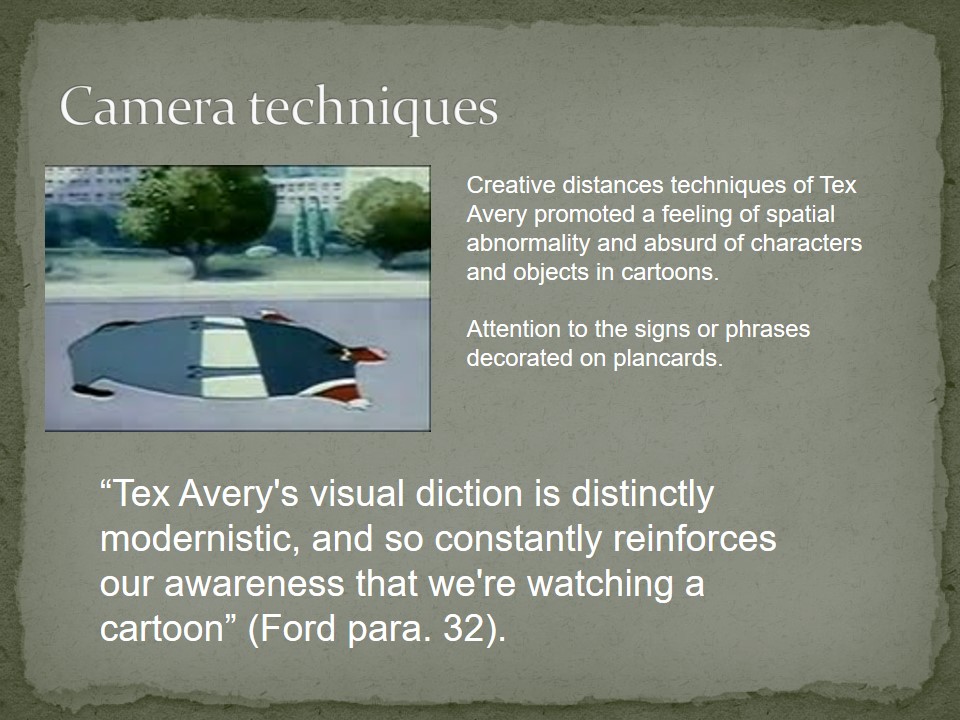
Animation Techniques
Improvisation was a “credit card” of Tex Avery.
He used his observation of spontaneous transformation of characters, as the tint of his modernist survey on realities of life.
Thus, in Red Riding Hood Avery was apt to make a transition of classical fairy tale into a modern implementation of sexy and pretty girl singning jazz music for the audience where the wolf appears, as a gangster in times of Great Depression.
Techniques by Avery contradicted those of Disney. Thereupon, he made his characters loudly speaking directly to the audience with unbelievable tricks supported a definite action or episode in the cartoon.
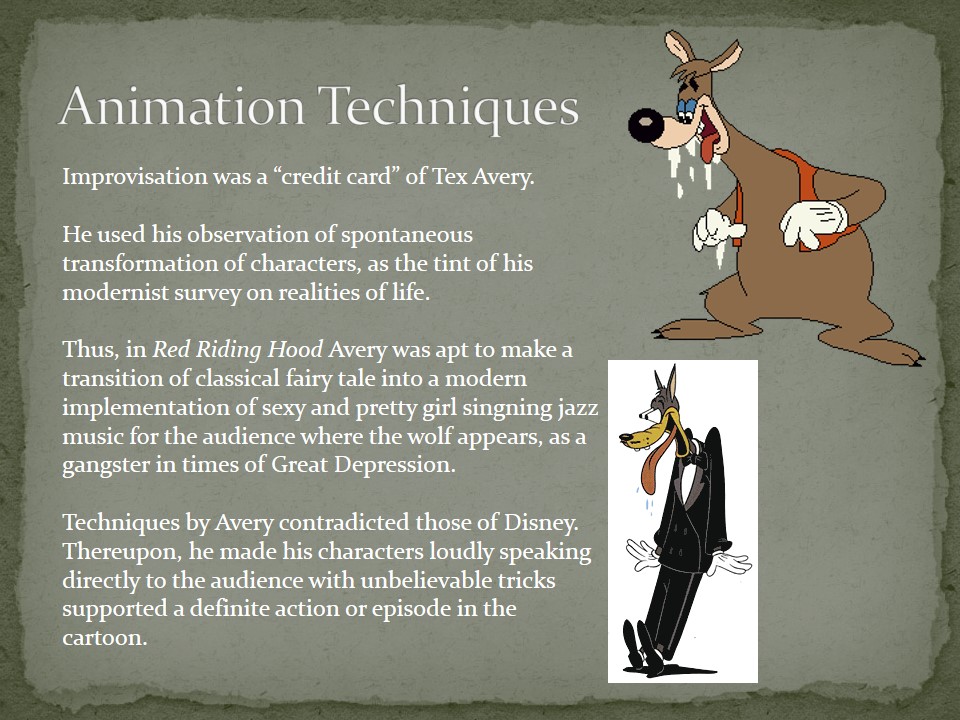
Techniques and technological approach
Tex Avery tried to follow the main urges for creativity in his work. His characters are considered to be viewed by means of television. In fact, with the spread of television Avery gained more popularity and his characters became known in many countries of the world. Moreover, Avery gave new drive toward the way of cartoons’ improvement in technological framing.
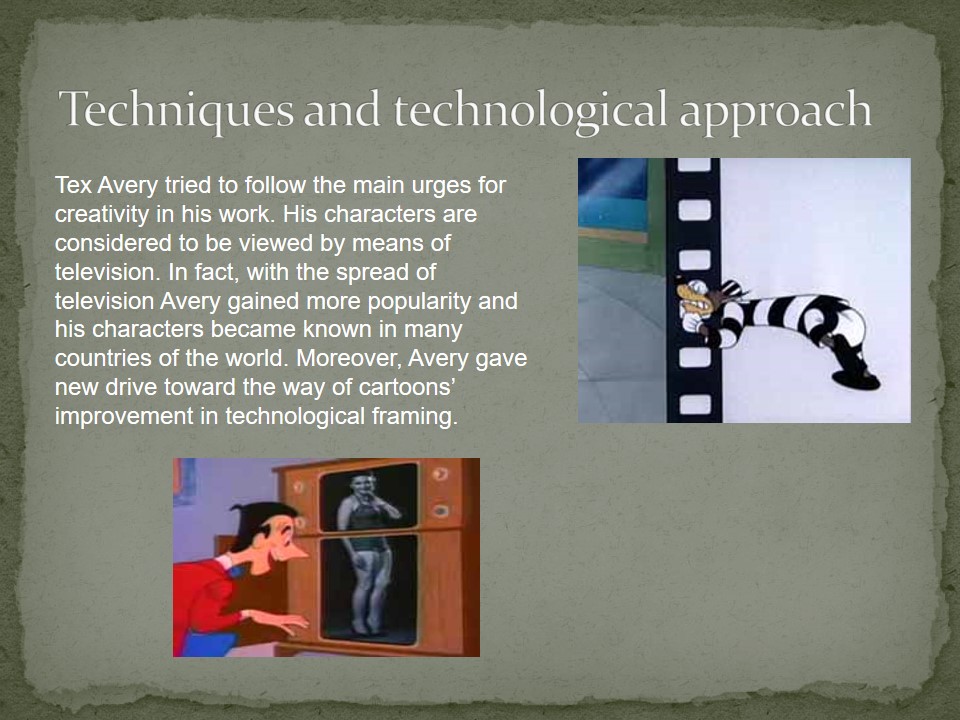
Parallels with contemporary writers
Perhaps, most of old people in America remember the character of fox in the cartoon Fox and Hounds.
The motivation of Avery to create fox, as a comparison of rather cunning person.
It is not surprising, that following the trend of literature Tex Avery incorporated in kthe image of fox the character of Lenny in Steinbeck’s Grapes of Wrath (Ford para. 17).
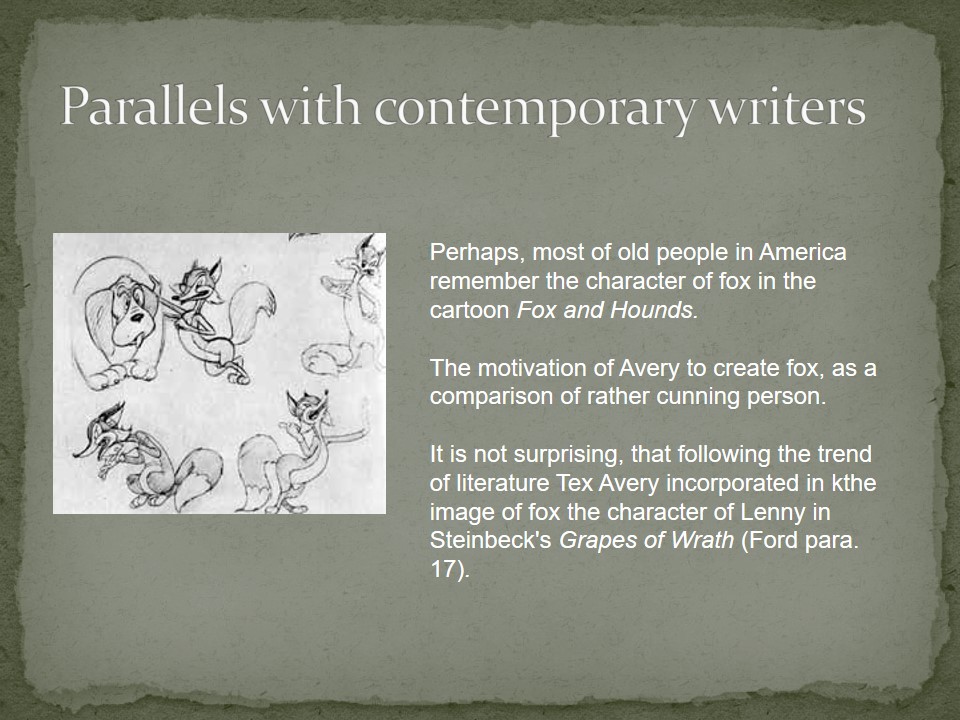
Deeper concernment in bad heroes
Steinbeck’s “Lenny” impressed Avery when he read the book by the author and then watched the film according to the book.
It was an impulse for him not to leave an idea that the irony of bad heroes is indicated in their bad final.
Of Mice and Men is the most viable confirmation of the idea above.

Timing
The artistic improvisation of Avery gained him much popularity when his closest rivals tried to stop him making cartoons which predicted the further times and need of people to laugh just for fun.
“The most famous trait of Avery’s cartoons are their extreme “takes“ (Rowley para. 4).
One more objective of his entire manifestation of originality which is adored and likely to be inherited from generation to generation is the emphasis on:
- Speed and Escalation;
- Gags;
- Rational spacing of jokes.
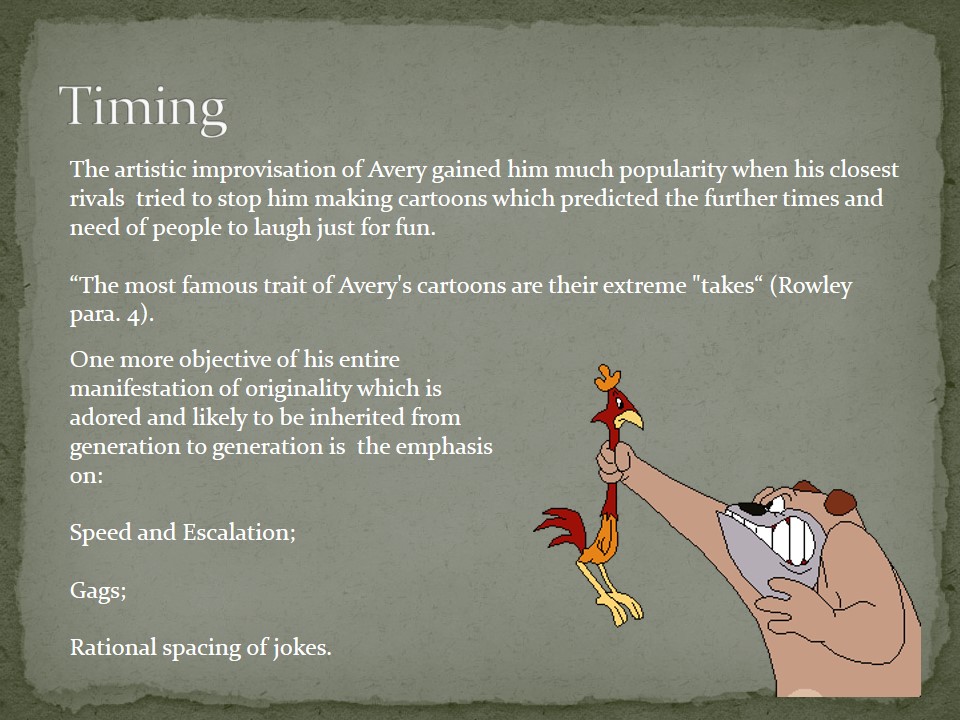
Exaggeration
Exaggeration is one of the loveliest tools in the arsenal of Avery.
He demonstrates incredible and rather unpredictable emergences of the characters in different places with various attributes.
Tex Avery tried to position himself, as a master of transformation in kthe funniest way.
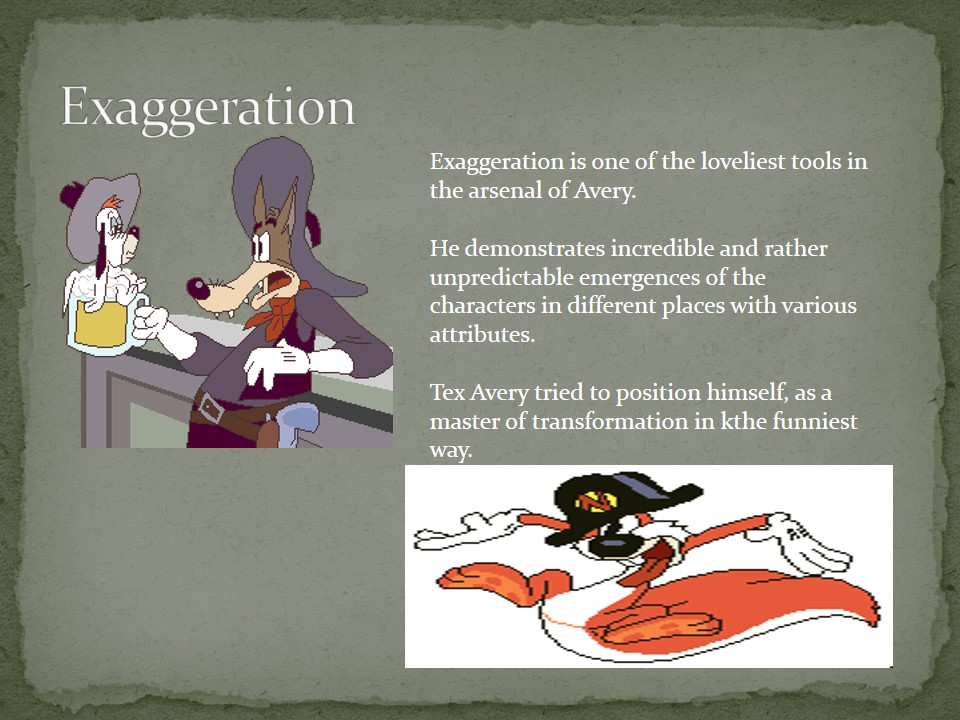
Exaggeration in action
Looking at the wholeness of cartoons which Tex Avery produced, one should mention that almost none of them is performed without feature of exaggeration.
This is seen in the talent and high capability of the author to make fantasy of his own comprise the circumstances in the cartoon. In other words, notwithstanding Disney’s cartoons Avery never stopped exagerating.
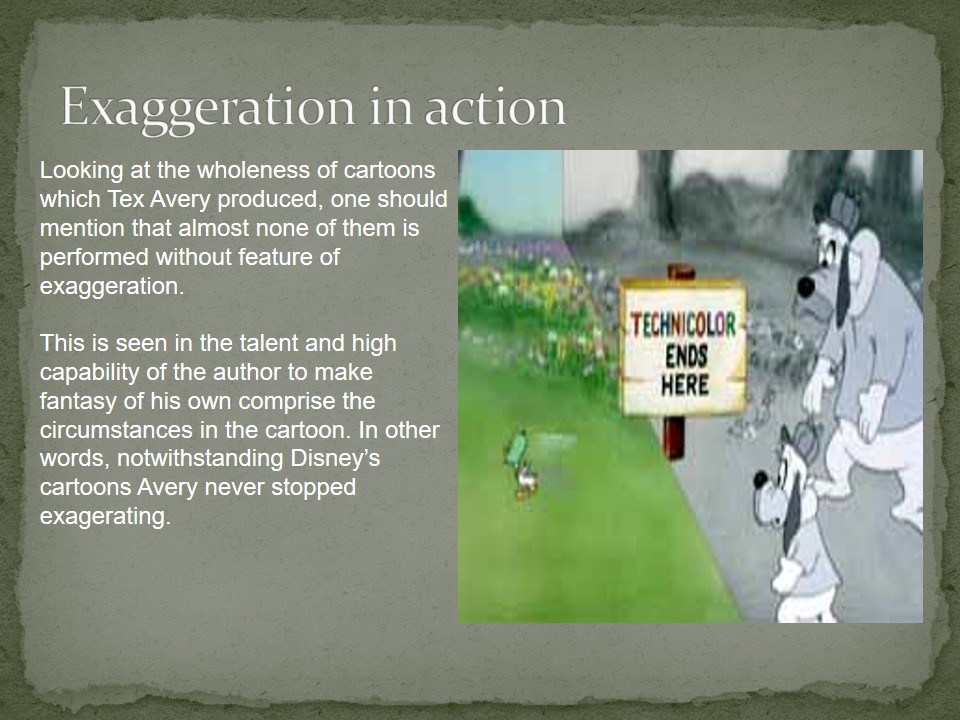
Appeal
Avery was also apt to include in his works a sort of morale or just occasional appeal of the characters to the audience.
In case with Bugs Bunny it is seen when this very character seems to provide a dialogue with viewers.
Mostly the anticipation of the happy end is developed between good and bad heroes. The appeal of bad character in the end of Avery’s shorts provides a trend of educational features for children within bursts of laughing.
The use of appeal was provided by Avery not in its serious frame. Avery tried to follow the ironical and even sarcastic destination of such means as appeal.
He never knew limits in making characters funnier than they are realized already by the audience.
“What’s Up, Doc?“ is a lovely phrase which every child knows from the very beginning of his/her life. This is demonstrated in Bugs Bunny with an unfazed persuasion in his mature and unrivalled beliefs to be not implicated in the hunter’s urge for bag.
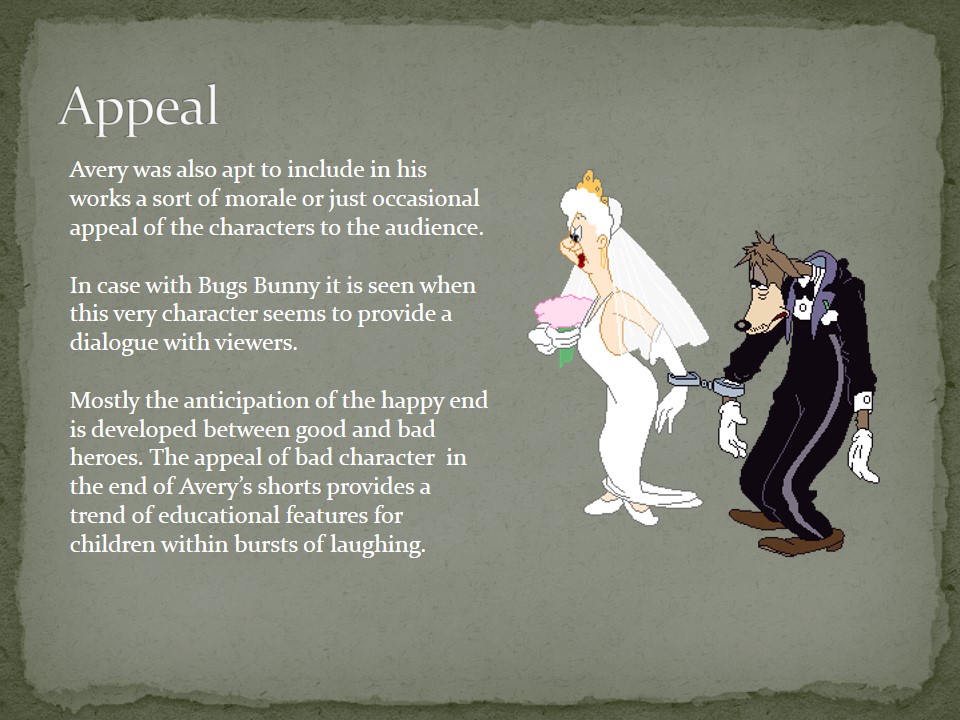
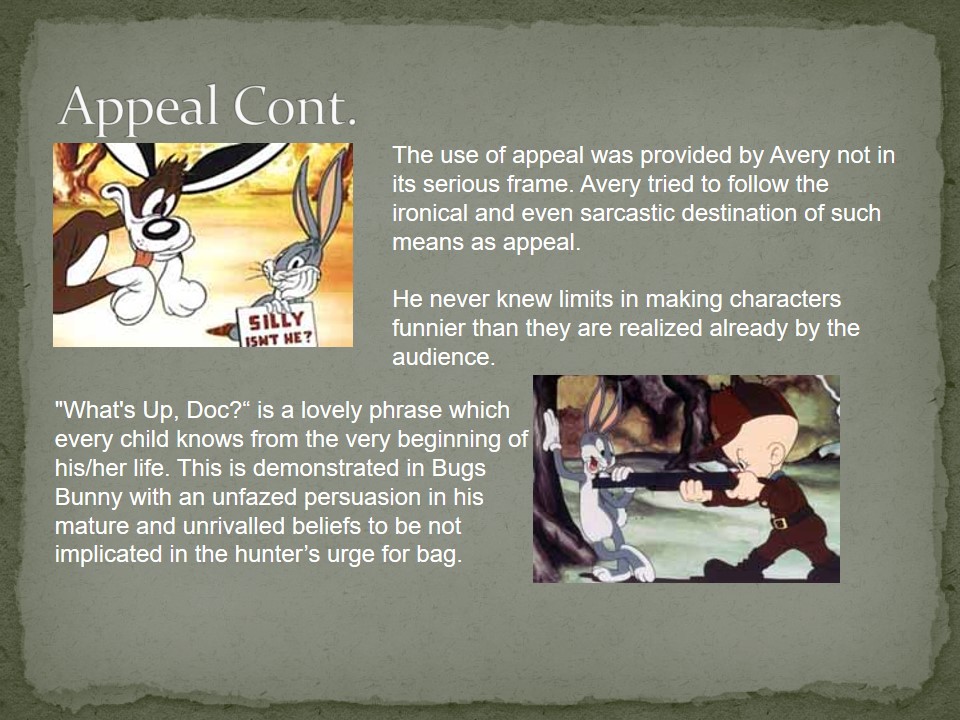
Works cited
Barrier, Michael. Tex Messaging. 2009. Web.
Ford, Greg. Tex Avery: Arch-Radicalizer of the Hollywood Cartoon. Bright Lights. 2009. Web.
Haase, Donald. The Greenwood Encyclopedia of Folktales and Fairy Tales.
Westport CT: Greenwood Publishing Group, 2008.
Morris, Gary. A quickie look at the life and career of Tex Avery. Bright Lights. September, 1998. Web.
Morris, Gary. ‘The Fairy Tales of Tex Avery’. Images Journal, 6, pp. 1-4. Web.
Rowley, Stephen. The Funniest Cartoon Ever? Odds & Ends. Sunday, 2006. Web.
Young ,Theo and Heisie, Josh. AVERY, Fred “Tex“. ASIFA Hollywood Animation Archive . 2005. Web.